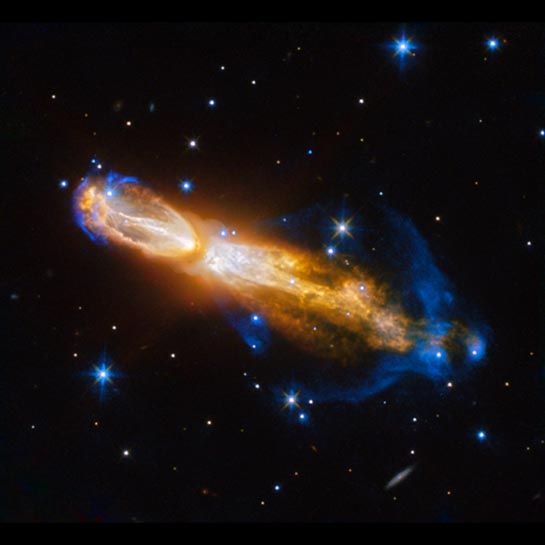
Planetary Nebula
RA 7h 42m 16.61s Dec -14° 42' 58.66"
Puppis
5000 light years
9.47
1.17 x 1.08 arcminutes
North is 45.9° left of vertical
ESA/Hubble & NASA, Ack: Judy Schmidt
January 30, 2017
2001 image: N0111
ABOUT THIS IMAGE:
The Calabash Nebula, pictured here - which has the technical name OH 231.8+04.2 - is a spectacular example of the death of a low-mass star like the Sun. This image taken by the NASA/ESA Hubble Space Telescope shows the star going through a rapid transformation from a red giant to a planetary nebula, during which it blows its outer layers of gas and dust out into the surrounding space. The recently ejected material is spat out in opposite directions with immense speed - the gas shown in yellow is moving close to a million kilometers an hour.
Astronomers rarely capture a star in this phase of its evolution because it occurs within the blink of an eye - in astronomical terms. Over the next thousand years the nebula is expected to evolve into a fully fledged planetary nebula.
The nebula is also known as the Rotten Egg Nebula because it contains a lot of sulphur, an element that, when combined with other elements, smells like a rotten egg - but luckily, it resides over 5000 light-years away in the constellation of Puppis (The Poop deck).
From Wikipedia:
The Calabash Nebula, also known as the Rotten Egg Nebula or by its technical name OH 231.84 +4.22, is a protoplanetary nebula (PPN) 1.4 light years (13 Pm) long and located some 5,000 light years (47 Em) from Earth in the constellation Puppis. The name "Calabash Nebula" was first proposed in 1989 in an early paper on the expected nebular dynamics, based on the nebula's appearance. The Calabash is an almost certain member of the open cluster Messier 46, as it has the same distance, radial velocity, and proper motion.
Violent gas collisions that produced supersonic shock fronts in a dying star are seen in a detailed image from NASA's Hubble Space Telescope.
The object is sometimes called the Rotten Egg Nebula because it contains a relatively large amount of sulfur. The densest parts of the nebula are composed of material ejected recently by the central star and accelerated in opposite directions. This material, shown as yellow in the image, is zooming away at speeds up to one and a half million kilometers per hour (one million miles per hour). Most of the star's original mass is now contained in these bipolar gas structures.
A team of Spanish and US astronomers used NASA's Hubble Space Telescope to study how the gas stream rams into the surrounding material, shown in blue. They believe that such interactions dominate the formation process in planetary nebulae. Due to the high speed of the gas, shock-fronts are formed on impact and heat the surrounding gases. Although computer calculations had predicted the existence and structure of such shocks for some time, previous observations had not been able to prove the theory.
This new Hubble image used filters that only let through light from ionized hydrogen and nitrogen atoms. Astronomers were able to distinguish the warmest parts of the gas heated by the violent shocks and found that they form a complex double-bubble shape. The bright yellow-orange colors in the picture show how dense, high-speed gas is flowing from the star, like supersonic speeding bullets ripping through a medium in opposite directions. The central star itself is hidden in the dusty band at the center.
Much
of the gas flow observed today seems to stem from a sudden acceleration
that took place only about 800 years ago. The astronomers believe that
1,000 years from now, the Calabash Nebula will become a fully developed
planetary nebula.